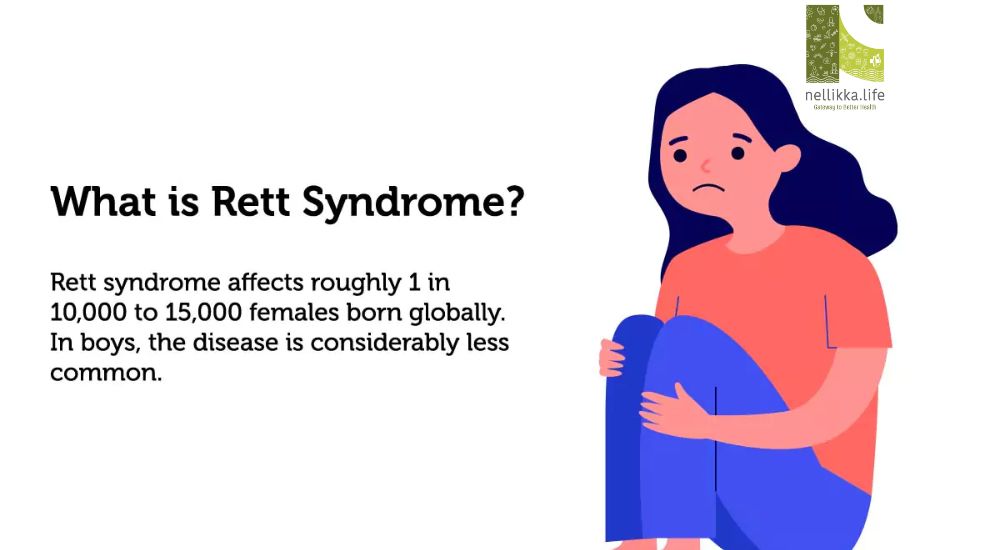Understanding Rett Syndrome: A Rare but Devastating Neurological Disorder

Rett Syndrome (RTT) is a rare genetic neurological disorder that almost exclusively affects girls and leads to severe cognitive and physical impairments. It may not be widely known, but for families and individuals living with Rett, the journey is emotionally and medically intense.
At Nellikka.life, we aim to bring attention to such underrepresented conditions to foster understanding, compassion, and early intervention.
What Is Rett Syndrome?
Rett Syndrome is a neurodevelopmental disorder caused by mutations in the MECP2 gene on the X chromosome. The condition leads to problems in brain function, especially those that control movement, speech, and coordination.
Although babies with Rett appear to develop normally for the first 6 to 18 months, symptoms begin to emerge in stages.
What Causes It?
Rett Syndrome is not typically inherited. It’s caused by a random mutation in the MECP2 gene, which is vital for normal brain development. Because the gene is on the X chromosome, and females have two X chromosomes, girls are predominantly affected. Boys with the mutation usually don’t survive infancy, as they have only one X chromosome.
Reference:
Stages of Rett Syndrome
Rett Syndrome progresses in four stages:
1. Early Onset (6–18 months)
- Subtle developmental delays
- Less eye contact
- Reduced interest in play
2. Rapid Regression (1–4 years)
- Loss of purposeful hand skills
- Speech regression
- Repetitive hand movements (e.g., wringing, tapping)
- Gait abnormalities
3. Plateau (Preschool to school years)
- Stabilization in regression
- Improved eye contact
- Some improvements in behavior
4. Late Motor Deterioration (After age 10)
- Decreased mobility
- Muscle weakness
- Scoliosis
- Breathing difficulties
Common Symptoms
- Loss of speech and hand skills
- Repetitive hand movements
- Seizures
- Intellectual disability
- Irregular breathing (hyperventilation, apnea)
- Motor coordination issues
- Growth retardation
Diagnosis
Diagnosis is usually clinical, based on observed symptoms and genetic testing to confirm MECP2 mutations.
Early diagnosis helps with:
- Therapy planning
- Family counseling
- Avoiding misdiagnoses (e.g., autism, cerebral palsy)
Reference:
Is There a Cure?
As of now, there is no cure for Rett Syndrome. However, management and therapies can significantly improve the quality of life:
- Physiotherapy – to maintain mobility
- Occupational therapy – to build daily living skills
- Speech therapy – non-verbal communication support
- Medications – for seizures, breathing issues, and mood stabilization
- Nutritional support – due to feeding difficulties
What Does Research Say?
Hope is on the horizon.
Studies using gene therapy and MECP2 reactivation in animal models have shown promise. For example:
- Gene replacement therapy trials are currently underway.
- Trofinetide, a novel treatment developed by Acadia Pharmaceuticals, showed significant improvements in clinical trials. Reference link.
Life With Rett: For Families and Caregivers
Living with Rett Syndrome is challenging, but early intervention, proper care, and a strong support system can make a meaningful difference.
Support groups, special education, and caregiver counseling play vital roles. Empowered and informed caregivers ensure these children live with dignity and as much independence as possible.
Spreading Awareness
Rett Syndrome is rare but not invisible. Every share, conversation, and support extended helps affected families feel less alone.
At Nellikka.life, we encourage open discussions about rare diseases so that everyone—regardless of the diagnosis—receives the support and compassion they deserve.
🔗 Further Reading
- International Rett Syndrome Foundation
- NIH Genetics Home Reference – Rett Syndrome
- PubMed Central – Latest Rett Syndrome Studies
- OMIM (Online Mendelian Inheritance in Man): RETT SYNDROME Overview
- Boston Children’s Hospital – Rett Syndrome Overview
- EEG abnormalities
- Rett Syndrome Research Trust (RSRT)
Understanding Rett Syndrome is more than just recognizing symptoms. It’s about seeing the person behind the diagnosis and acknowledging the resilience of families who face the condition every day.
Follow us at Nellikka.life for more updates, expert interviews, and inspiring stories from the world of health, wellness, and healing.




